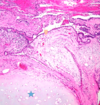Lung Tumors Flashcards
What is the reasoning as to why adenocarcinomas have increased in prevalence in more recent years?
• Filters on cigarettes may make us inhale deeper and pull the smoke into alveolar portion of the lungs
Differentiate a driver and passenger mutation.
Driver mutations are the mutations that allow the cell to become immortal in the first place.
Passenger mutations occur as a result of the rapid growth of the cell with a relatively unchecked genomic structure
What are the 2 common signal transduction pathways used by RTKs (receptor tyrosine kinases)?

T or F: as tumors proliferate they become a heterogenous mass of cells, all of which may have different mutagenic properties.
True, as cancer proliferates passenger mutations may accumulate and confer advantages to certain cells.
What are oncogenes?
Viral or Cellular (proto-oncogenes) genes that encode proteins needed to subvert normal growth control mechanisms
T or F: proteins driving cancer are mutated versions of proteins normally present in the cell
FALSE, these genes may just be amplified causing overexpression of a normal gene product
What is lung cancer screeing a good idea?
Because Prognosis of cancer is related to the stage of cancer at the time of diagnosis
With what two key substances do we see cigarette smoke having a synergistic effect with in causing lung cancer?
Asbestos (construction workers, mechanics, miners, etc)
Radon (uranium miners, people in houses on top of radon heavy ground)
What is suggested by the fact that only 10% of smokers get lung cancer?
10% get lung cancer but the others don’t so there must be a predisposition to getting lung cancer
What are some reasons you might see a nodule in your lung on CXR?
• Hamartoma
• Granuloma
• Infection (particularly fungal, mycobacterial)
• Rheumatoid lung
• Silicosis
If you see a nodule on a CT scan of a smoker, what factors should you consider?
Is the patient high risk?
- do they smoke, how old, other exposures, hemoptysis, other malignancies
Is the nodule high risk?
- Size (more than 3cm, typically malignant, less than 0.8 typically not), location (upper lung - favors malignancy), Appearance (spiculated or calcified), Growth
What physical characterisitics of a lung tumor would make you think it is maligant?
A mass greater than 3cm, that appeared as a spiculated lesion in the upper lobe, that was growing
What physical characteristics of a tumor would make you think its benign?
A mass smaller than 0.8cm that is not in the upper lobe and appears calcified without evidence of growth
What is a hamartoma?
• describe what they are?
• What tissue are they typically composed of when in the lung?
Hamartoma is **normal tissue that is abnormally arranged
•**
Typically this just looks like a rounded COIN LESION on x-ray, that is PERIPHERALLY located, SOLITARY, and WELL CIRCUMSCRIBED.
• these are nodules of MATURE connective tissue that show evidence that they may be neoplastic
What is a choristoma?
Choristoma - normal tissue in an abnormal location
What is this lesion and what would you expect it to look like on CXR?
• describe the key gross characteristics.

Key gross characteristics: Lobulated, grey-white glistening nodule
Hamartoma - typically present as well circumscribed solitary coin lesions near the periphery.

This tissue was biopsied from someone’s lung.
• is this mass benign or maligant?
• how do you know?

Benign, this is a haratoma containing Cartilage, Fat, and respiratory Epithelial cells. None of the components of this specimen appear to be neoplastic (all tissue is neatly formed).

What are the 4 histologic type of primary lung cancer?
- *1. Adenocarcinoma
2. Squamous cell carcinoma
3. Large cell carcinoma
4. Small cell carcinoma**
Note: 87% of people with lung cancer are smokers or ex-smokers. People who smoke 1 ppd have a 10x risk of getting lung cancer. People who smoke 2 ppd have a 60x risk of getting lung cancer
Note: 87% of people with lung cancer are smokers or ex-smokers. People who smoke 1 ppd have a 10x risk of getting lung cancer. People who smoke 2 ppd have a 60x risk of getting lung cancer
Do you expect this mass to be cancerous when a biopsy is done?
Yes this is a PERIPHERALLY located spiculated mass that appears to be large
• Peripheral location implies that this is an adenocarcinoma or Bronchoalveolar carcinoma
(note: Gupta does not seem to distinguish between these two, instead uses the term lepidic growth pattern of adenocarcinoma)

What is the most common histological type of cancer among non-smokers and female smokers?
• what are some key features of this cancer?
Most common histologic type:
• Lung Adenocarcinoma, these tumors are glandular and often produce mucin
What is lepidic growth?
• what type of lung cancer is this associated with?

Lepidic growth - tumor that creeps along that alveoli to thicken them and sometimes gives a pneumonia-like consolidation appearance
What’s in your differential when you see a tumor as shown here?

This tumor appears as a single mass and is peripherally located. this indicates two things:
- This is probably a primary lung cancer b/c its a single lesion
- Peripheral location means it could be Adenocarcinoma (or bronchoalveolar) OR Large Cell carcinoma
What is this showing?

Adenocarcinoma that has caused a pneumonia-like consolidation in an entire lobe


























